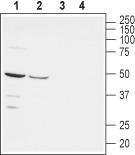PVRL1 (NECTIN1) Rabbit Polyclonal Antibody
Other products for "NECTIN1"
Specifications
| Product Data | |
| Applications | FC, IF, IHC, WB |
| Recommended Dilution | WB: 1:200-1:2000; IHC: 1:100-1:3,000; FC: 1:50-1:600 |
| Reactivities | Human, Mouse, Rat |
| Host | Rabbit |
| Clonality | Polyclonal |
| Immunogen | Peptide (C)GKPPSVVSWETRLK, corresponding to amino acid residues 177- 190 of human nectin-1. Extracellular, N-terminus. |
| Formulation | Lyophilized. Concentration before lyophilization ~0.8mg/ml (lot dependent, please refer to CoA along with shipment for actual concentration). Buffer before lyophilization: phosphate buffered saline (PBS), pH 7.4, 1% BSA, 0.025% NaN3. |
| Purification | Affinity purified on immobilized antigen. |
| Conjugation | Unconjugated |
| Storage | Store at -20°C as received. |
| Stability | Stable for 12 months from date of receipt. |
| Gene Name | nectin cell adhesion molecule 1 |
| Database Link | |
| Background | Nectins, which were originally identified as virus receptors, are members of the cell-cell adhesion molecule (CAM) family. They are Ca2+-independent immunoglobulin-like CAMs. The nectin family comprises four members, nectin-1, nectin-2, nectin-3 and nectin-4, which are encoded by the PVRL1, PVRL2, PVRL3 and PVRL4 genes, respectively. In the central nervous system, these cell adhesion molecules aggregate in formations, termed puncta adherentia junctions, which are mechanical adhesive sites that connect pre- and postsynaptic membranes. All nectins contain an extracellular region with three immunoglobulin-like loops (one V type and two C2 types), a single membrane-spanning region and a cytoplasmic tail. Nectins directly bind afadin, an F-actin-binding protein, through their cytoplasmic tails. Nectin-1 is expressed at cell-cell junctions in human and mouse epidermis. In mice lacking the gene encoding nectin-1 (Pvrl1-/- mice), the expression of loricrin, a differentiation marker and a major component of cornified cell envelopes in the epidermis, is downregulated and newborn pups have a shiny and slightly reddish skin. Mutations in human PVRL1 are implicated in cleft lip or palate-ectodermal dysplasia syndromes, which includes Zlotogora–Ogur syndrome and Margarita Island ectodermal dysplasia. Both of these are autosomal recessive disorders that are clinically characterized by unusual facial appearance, dental anomalies, hypotrichosis, palmoplantar hyperkeratosis and onychodysplasia, syndactyly, cleft lip or palate, and in some cases, mental retardation. |
| Synonyms | CD111; CLPED1; ED4; HIgR; HV1S; HVEC; nectin-1; OFC7; PRR; PRR1; PVRL1; PVRR; PVRR1; SK-12 |
| Note | This antibody was tested in live cell imaging. Please see IF/ICC data for detail. |
| Reference Data | |
| Protein Families | Druggable Genome, ES Cell Differentiation/IPS, Transmembrane |
| Protein Pathways | Adherens junction, Cell adhesion molecules (CAMs) |
Documents
| Product Manuals |
| FAQs |
{0} Product Review(s)
0 Product Review(s)
Submit review
Be the first one to submit a review
Product Citations
*Delivery time may vary from web posted schedule. Occasional delays may occur due to unforeseen
complexities in the preparation of your product. International customers may expect an additional 1-2 weeks
in shipping.






























































































































































































































































 Germany
Germany
 Japan
Japan
 United Kingdom
United Kingdom
 China
China







